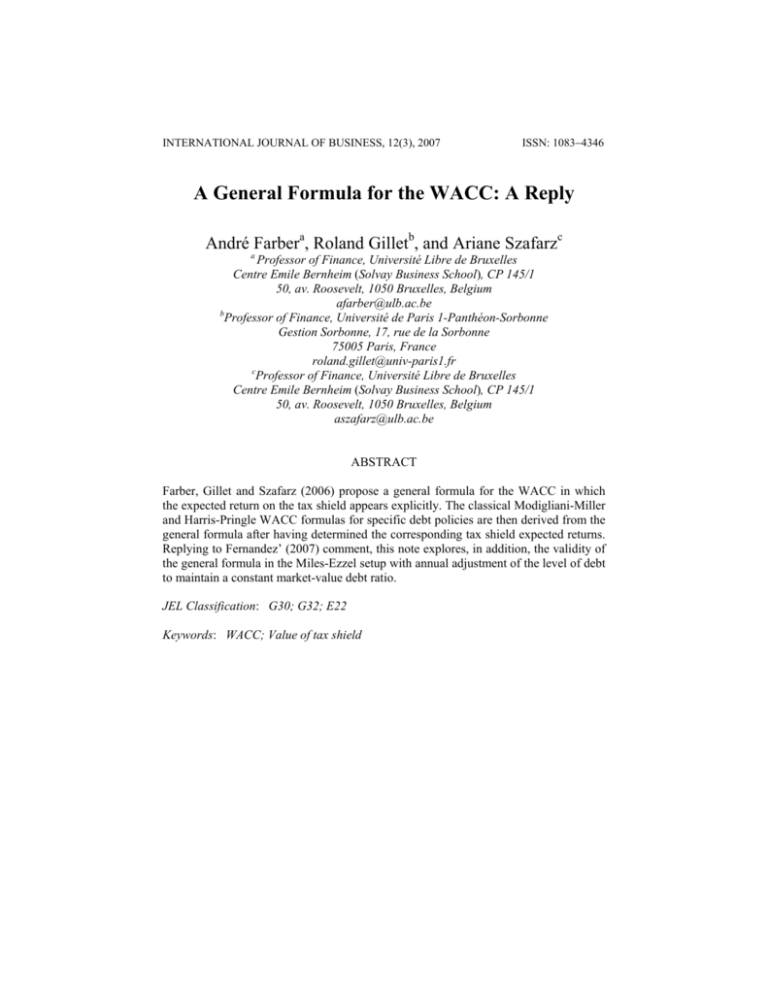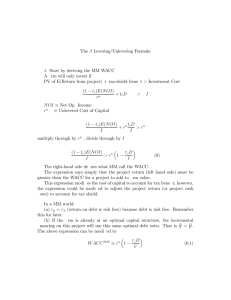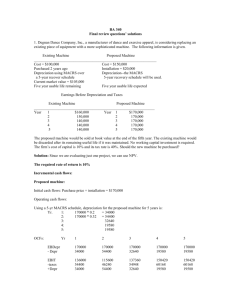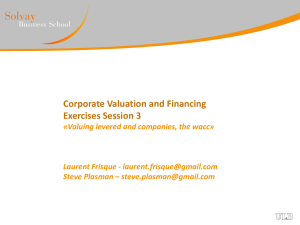
INTERNATIONAL JOURNAL OF BUSINESS, 12(3), 2007
ISSN: 1083−4346
A General Formula for the WACC: A Reply
André Farbera, Roland Gilletb, and Ariane Szafarzc
a
Professor of Finance, Université Libre de Bruxelles
Centre Emile Bernheim (Solvay Business School), CP 145/1
50, av. Roosevelt, 1050 Bruxelles, Belgium
afarber@ulb.ac.be
b
Professor of Finance, Université de Paris 1-Panthéon-Sorbonne
Gestion Sorbonne, 17, rue de la Sorbonne
75005 Paris, France
roland.gillet@univ-paris1.fr
c
Professor of Finance, Université Libre de Bruxelles
Centre Emile Bernheim (Solvay Business School), CP 145/1
50, av. Roosevelt, 1050 Bruxelles, Belgium
aszafarz@ulb.ac.be
ABSTRACT
Farber, Gillet and Szafarz (2006) propose a general formula for the WACC in which
the expected return on the tax shield appears explicitly. The classical Modigliani-Miller
and Harris-Pringle WACC formulas for specific debt policies are then derived from the
general formula after having determined the corresponding tax shield expected returns.
Replying to Fernandez’ (2007) comment, this note explores, in addition, the validity of
the general formula in the Miles-Ezzel setup with annual adjustment of the level of debt
to maintain a constant market-value debt ratio.
JEL Classification: G30; G32; E22
Keywords: WACC; Value of tax shield
406
Farber, Gillet, and Szafarz
I.
INTRODUCTION
In his comment, Fernandez (2007) claims that the general formulation of the WACC
proposed in Farber, Gillet, Szafarz (FGS, 2006) is only correct under the assumption
that the required returns are constant over time. Moreover, he argues that “it is not
possible to derive a debt policy such that the appropriate discount rate for the tax shield
is rA in all periods” (where rA is the cost of capital for the unlevered firm).
These statements are incorrect. First, the general formula of the WACC in FGS
(2006) is derived from the equality between the average return on both side of the
market-value balance sheet. It should be satisfied at any point in time and, more
importantly, it does not imply that the WACC is a constant. Of course, if all variable
entering the formula are constant, the resulting WACC is a constant. But, as shown in
this paper, a constant WACC can also be obtained when some of the variables vary
over time.
Second, as shown by several authors (see, for instance, Taggart, 1991 or Arzac
and Glosten 2005), the expected return on the tax shield is equal to the cost of capital of
the unlevered firm for a leverage policy with continuous rebalancing of the level of debt
to maintain a fixed leverage ratio. This financial policy was initially analyzed by Harris
and Pringle (1985). Fernandez’ comment refers to the Miles and Ezzell (1980) setting
where the firm rebalances its debt once a year instead of continuously, a case not
considered in FGS (2006).
The rest of this paper proceeds as follow. Section 1 shows that the formulation of
the WACC in FGS (2006) is indeed general and does not require assuming constant
returns over time. Section 2 derives the classical WACC formulas of Modigliani Miller
(1963) and Harris Pringle (1985), the latter corresponding to the Miles and Ezzel (1980)
case with continuous rebalancing. Section 3 examines whether the general formula
applies in a Miles-Ezzel setup with annual rebalancing and arbitrary cash-flows.
Section 4 considers the use of the general formula under perpetual growth. General
conclusions are presented in section 5.
II.
THE GENERAL WACC FORMULA
The general formula for the WACC (Equation (18) in FGS, 2006) is:
WACC = rA (1 −
VTS
D
VTS
) − rD TC + rTS
V
V
V
(1)
where rA, rD and rTS are the expected returns respectively on the unlevered firm, the debt
and the tax shield, V is the value of the levered firm, VTS is the value of the tax shield,
D is the value of the debt and TC is the corporate tax rate.
This formula is derived from the balance sheet identity and the definition of the
weighted average cost of capital (for a similar presentation, see Berk and De Marzo,
2007). It should therefore be verified at any point in time, whatever returns are annually
or continuously compounded.
To exhibit this, start with the accounting identity (time indices have been added
for clarification):
INTERNATIONAL JOURNAL OF BUSINESS, 12(3), 2007
Vt = VUt + VTSt = Et + Dt
407
(2)
where VUt is the value of the unlevered firm.
Assuming, for simplicity, that the corporate tax rate is constant over time, the
weighted average cost of capital is defined as:
WACC t ≡ rE, t
Et
D
+ rD, t (1 − TC ) t
Vt
Vt
(3)
From (2), the expected returns on both side of the balance sheet should be equal:
rA, t
VU t
VTS t
E
D
+ rTS, t
= rE, t t + rD, t t
Vt
Vt
Vt
Vt
(4)
As:
VU t = Vt − VTS t
(5)
and, from (3)
rE, t
Et
D
= WACC − rD, t (1 − TC ) t
Vt
Vt
(6)
the general formula for the WACC is:
WACC t = rA, t (1 −
VTS t
D
VTS t
) − rD, t TC t + rTS, t
Vt
Vt
Vt
(7)
This equation is the general formula in FGS (2006).
III.
THE MODIGLIANI-MILLER AND HARRIS-PRINGLE FORMULAS
Although Eq. (7) is fully general, its practical applicability requires additional
conditions. Indeed, when the WACC is constant over time, the value of a levered firm
can be computed by discounting with the WACC the unlevered free cash-flows.
Therefore, we pay a special attention to the special cases that make the WACC
constant. The resulting particular formulas can also be found in textbooks (Brealey et
al., 2006; Ross et al., 2005). As in all papers devoted to this topic, we assume here that
rA,t = rA and rD,t = rD are constant.
First, Modigliani and Miller (1963) assume that the level of debt D is constant.
Then, as the expected after-tax cash-flow of the unlevered firm is fixed, VU is also
constant. By assumption, rTS = rD and the value of the tax shield is VTSt = TCD.
Therefore, the value of the firm V is a constant and the general WACC formula (7)
simplifies to a constant WACC:
408
Farber, Gillet, and Szafarz
WACC t = rA − rA TC L for all t
(8)
with L = D/V.
Second, Harris and Pringle (1985) assume that the level of debt is rebalanced
continuously so as to maintain a constant debt ratio Dt/Vt = L. Moreover, as the level of
debt is always proportional to the value of the unlevered firm, the expected return on
the tax shield is the same as the cost of capital of the unlevered firm (rTS = rA). As a
consequence, this implies a constant WACC:
WACC t = rA − rD TC L for all t
(9)
where rA and rD are continuously compounded returns (see: Taggart, 1991, and Arzac
and Glosten, 2005). It is worth noting that formula (9) does not require the calculation
of VTS. Moreover, Eq. (9) shows that, with constant rA, rD and TC , a constant WACC
may only be result from a constant debt ratio L. Any other financial policy makes the
WACC time-varying.
IV.
MILES-EZZEL WITH ANNUAL REBALANCING AND ARBITRARY
CASH-FLOWS
We now apply the general formula (7) to the Miles and Ezzel (1980) setup where the
debt is rebalanced once a year and cash-flows are arbitrary, a case not considered in
FGS (2006).
Formula (7) can be written as:
WACC t = rA − rD TC L + (rTS, t − rA )
VTS t
Vt
(10)
With arbitrary cash-flows, both rTS,t and VTSt /Vt may vary over time. Under
what condition does the WACC remain constant?
From Eq. (10), the condition is: the product (rTS,t - rA)(VTSt/Vt) is constant. This
condition is met by the Miles-Ezzell leverage policy with annual rebalancing. Indeed,
these authors obtain the following value for the tax shield at time t:
T r LV VTS t +1
VTS t = C D t +
1 + rD
1 + rA
(11)
The next year tax shield is discounted at the cost of debt whereas the expected
future value of the tax shield is discounted at the cost of capital of the unlevered firm.
By definition, the expected return on the tax shield is:
T r LV + (VTS t +1 − VTS t )
rTS, t = C D t
VTS t
Using (11):
(12)
INTERNATIONAL JOURNAL OF BUSINESS, 12(3), 2007
T r )(1 + rA )Vt
VTS t +1 − VTS t = rA VTS t − C D
1 + rD
409
(13)
Therefore:
T r L Vt
rTS, t = rA + (rD − rA ) C D ⋅
1 + rD VTS t
(14)
Formula (14) shows that rTS,t is inversely related to the fraction of the value accounted
by the tax shield. For instance, with a finite horizon T and VTST = 0 , the value of the
tax shield at time T-1 is obtained from (11) as :
T r LV
VTS t −1 = C D t −1
1 + rD
(15)
and:
rTS, t −1 = rD
(16
Since the dynamics of the unlevered cash-flows is arbitrary, Vt may well vary with
time, so that both rTS,t and VTSt / Vt change as well. However, the WACC remains
constant because:
(rTS, t − rA )
VTS t
T r L
= (rD − rA ) C D for all t
Vt
1 + rD
(17)
Replacing in the general formula (7), we obtain the Miles-Ezzell formula for the
WACC with annual rebalancing:
WACC t = rA − rD TC L
V.
1 + rA
for all t
1 + rD
(18)
MILES EZZEL WITH ANNUAL REBALANCING AND CONSTANT
GROWTH
Consider now a firm whose (unlevered) free cash-flows grow at a constant rate g. In
order to derive the expected return on the tax shield for this firm, let us start from the
formula for VTSt obtained by Arzac and Glosten (2005) (their Eq. (13)):
T r D (1 + rA )
VTS t = C D t
(rA − g )(1 + rD )
(19)
410
Farber, Gillet, and Szafarz
Therefore, the constant ratio of the value of the levered firm accounted to the value the
tax shield is:
Vt
(r − g)(1 + rD )
= A
VTS t
TC rD L(1 + rA )
(20)
Replacing in (14), the constant expected return on the tax shield is given by:
(r − g)
rTS = rA + (rD − rA ) A
(1 + rA )
(21)
With perpetual constant growth, the expected return on the tax shield is constant over
time and positively related to the growth rate. In the special case where g = 0, it
simplifies to:
rTS = rA
1 + rD
(1 + rA )
(22)
where the ratio (1+rD)/(1+rA) captures the impact of annual rebalancing (as opposed to
continuous rebalancing) on the expected return of the tax shield.
Finally, appropriate replacements in the general formula lead again to Eq. (18),
the Miles-Ezzell formula with annual rebalancing.
VI.
CONCLUSIONS
The formula proposed in FGS (2006) is general as claimed originally. It is a timeindependent identity which does not depend on the model used to value the tax shield.
The WACC formulas of Modigliani-Miller (constant debt) and Harris-Pringle (constant
debt ratio with continuous rebalancing) can be seen as special cases of this general
formula. Moreover, in the Miles-Ezzell setup (constant debt ratio with annual
rebalancing), a constant WACC is obtained because variations in the expected return on
the tax shield compensate variations in the fraction of the firm accounted by the value
of the tax shield.
Whether the Miles and Ezzel model is realistic or not regarding firms’ debt
structure remains an open question lying outside the scope of the current paper. Further
work could also address the discrete vs. continuous time scale assumptions and their
consequence regarding the WACC calculations.
Finally, we thank Pablo Fernandez for pointing out the importance and
complexity of these issues and offering us the possibility to clarify our point and
exhibiting additional applications of the WACC general formula.
REFERENCES
Arzac, E.R., and L.R. Glosten, 2005, “A Reconsideration of Tax Shield Valuation”,
European Financial Management, 11/4, pp. 453-461.
INTERNATIONAL JOURNAL OF BUSINESS, 12(3), 2007
411
Berk, J., and P. DeMarzo, 2007, Corporate Finance, Boston: Pearson-Addison Wesley.
Brealey, R., S. Myers and F. Allen, 2006, Corporate Finance, 8th ed., New York:
McGrawHill.
Farber, A., R. Gillet, and A. Szafarz, 2006, “A General Formula for the WACC”,
International Journal of Business, 11/2, pp. 211-218.
Fernandez, P., 2007, “A General Formula for the WACC: a Comment”, International
Journal of Business, this issue.
Harris, R., and J. Pringle, 1985, “Risk-Adjusted Discount Rates – Extension form the
Average-Risk Case”, The Journal of Financial Research, 8/3, pp. 237-244.
Miles, J.A., and J.R. Ezzel, 1980, “The Weighted Average Cost of Capital, Perfect
Capital Markets and Project Life: A Clarification” Journal of Financial and
Quantitative Analysis, 15/3, pp. 719-730.
Modigliani, F., and M. Miller, 1963, “Corporate Income Taxes and the Cost of Capital:
a Correction” American Economic Review, 53, pp. 433-443.
Ross, S., R. Westerfiel, and D. Jaffee, 2005, Corporate Finance, 7th ed., New York:
McGraw Hill.
Taggart, R.A., 1991, “Consistent Valuation and Cost of Capital Expressions with
Corporate and Personal Taxes”, Financial Management, 20, pp. 8-20.









